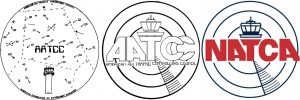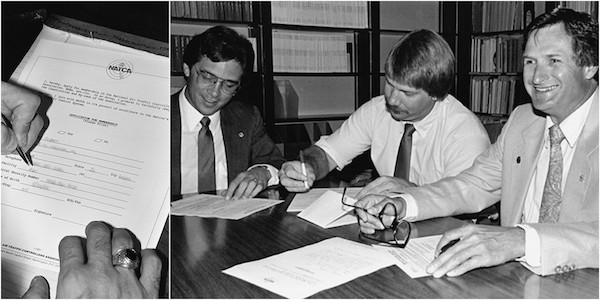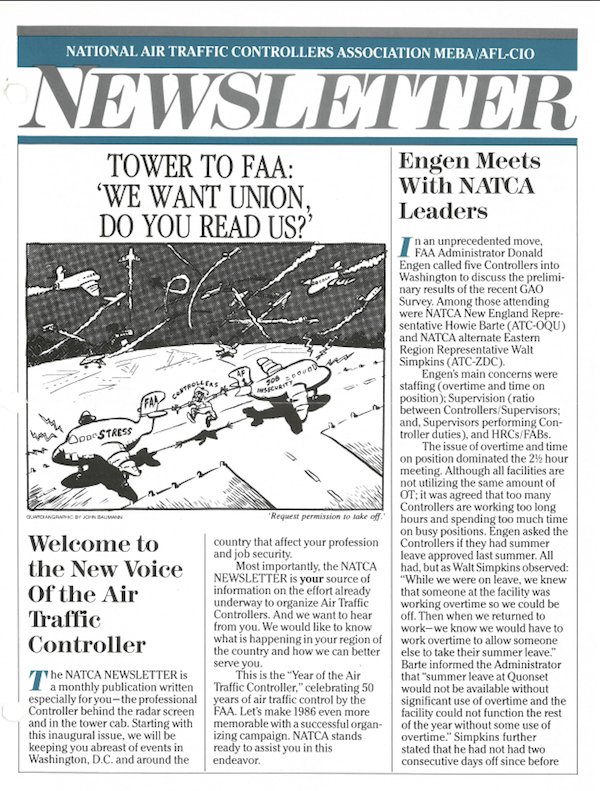
The Origin of the NATCA Name and Logo

The evolution of the NATCA logo from the AATCC organizing effort to NATCA name we all know today. The left image is Barte’s first AATCC logo. The middle image is a cleaned up version a commerical artists assisted Barte with. The last image is the NATCA logo as it exists today after a MEBA-affiliated artist switched out AATCC for NATCA after MEBA agreed to fund the young union. In 1981, Ronald Reagan took office as President and the Professional Air Traffic Controllers Organization (PATCO) went on strike, two events that set into motion a new age for organized labor in aviation. Frustrated with the status quo, PATCO members demanded better working conditions, better pay, and a 32-hour workweek. Three hours before the proposed strike, the Reagan administration opposed any further concessions to air traffic controllers, forcing PATCO to vote on whether to strike. They narrowly met the strike authorization point, with 80.5 percent of the membership voting in favor.
Despite the vote, a lot of the workforce was worried about growing tensions with the government. Many PATCO controllers felt that the strike would help their cause because of a letter from President Reagan to PATCO President Robert Poli on Oct. 20, 1980, in which he stated, “You can rest assured that if I am elected President, I will take whatever steps are necessary to provide our air traffic controllers with the most modern equipment available and to adjust staff levels and workdays so that they are commensurate with achieving a maximum degree of public safety.”
Unfortunately, the President did not hold himself to that promise once elected and came down on the striking workforce with unprecedented force. He fired three-quarters of the workforce — more than 11,000 workers. Almost immediately, federal judges moved to impound PATCO’s $3.5 million strike fund and impose $100,000-per-hour fines, effectively bankrupting the union. On Oct. 22, 1981, the Federal Labor Relations Authority (FLRA) decertified PATCO, leaving its members without representation.
In the fall of 1983, a group of controllers at Washington Center (ZDC) formed a facility-based organization. The group recognized that continuing to organize was the only way to fairly resolve their labor issues and they contacted AFGE to get started. They recruited former PATCO Facility Representative John Thornton to assist with their efforts. He became a tireless advocate for the young union and was essential in shaping NATCA as it exists today.
The ZDC controllers first began meeting regularly after work. The facility needed more controllers so that they could cut back on overtime hours and had several other issues that needed to be addressed with management. Thornton worked closely with fellow organizer Howie Barte, who was the first to sketch the AATCC logo. It was modeled after a radarscope with a control tower imposed. He later worked with an artist to clean up the logo, creating the tower anchor within the acronym that is definitive of the NATCA logo as it exists today.
Word about AATCC spread quickly through the new controller workforce and, as President Reagan was elected for a second term, Thornton’s organizing efforts began to reach national levels. Controllers from New York, Atlanta, Florida and New England began calling in for more information and activists like Joe O’Brien out of New York TRACON began joining the organizers from across the country, inspired by the message of solidarity.
 |
| Some of the first controllers to fill out their membership form with NATCA. Ray Spickler (left) Alternate Regional Vice President of Central Region under Dan Brandt, Dan Brandt (center) Central Region RVP, and Dennis Delaney (right), Southern Region RVP. |
The organizing efforts were gaining traction quickly and Thornton and Barte worked together to find funding for the controllers’ organizing efforts after support and money from their first funding association, AFGE, dissipated by late 1985. At that point, Barte recalls, AFGE had reduced organizing funding to “just my long distance phone bill and nothing else.”
In October 1985, Gene DeFries, the president of the Marine Engineers Beneficial Association (MEBA), called Barte to say MEBA would fund them. The only condition was that the information could not be released until December. DeFries asked Barte to become national coordinator for the new union but he refused. Barte said he told him, “the guy he wanted was John Thornton. He hired John in December 1985.”
December 2, 1985, Barte and DeFries made the official announcement that MEBA would organize air traffic controllers. With the AATCC name now tied to the failed bid for AFGE funding, Thornton and Barte knew there had to be a name change and they met to go over five-letter acronyms. They knew that rehashing PATCO would leave them with little hope of being successful. Replacing “Organization” with “Association” in PATCO was suggested, but “PATCA” was deemed by those involved to be too similar to the now defunct PATCO. Thornton and Barte decided on National Air Traffic Controllers Association (NATCA) instead. On Dec. 16, 1985, they adopted the NATCA name and created the now iconic logo with a MEBA artist changing the name AATCC to NATCA.
 |
| The cover of the first NATCA newsletter. |
Once in motion, NATCA’s momentum was unstoppable. On Dec. 30, 1985, NATCA’s first organizing letter was drafted and then sent to 40-to-50 activists across the country. A week later, on Jan. 11, NATCA held its first national organizing meeting in Alexandria, Va., where Thornton directed the proceedings. There, the NATCA logo was used officially for the first time. Shortly after, the first NATCA newsletter was mailed out to the membership.
NATCA’s success continued. On June 11,1987, NATCA’s National Executive Board went to count ballots on the vote for NATCA to be the sole bargaining unit for air traffic controllers. An overwhelming 70 percent of the controller workforce voted in favor of NATCA and the FLRA acted quickly. One week later, on June 19, 1987 the FLRA recognized NATCA as the sole bargaining representative for air traffic controllers. It was a culmination of the efforts started by a small group of controllers in Washington, D.C., and seen through by Thornton, Barte, O’Brien and all of the activists who remained resolute in their vision that NATCA was the way forward.

